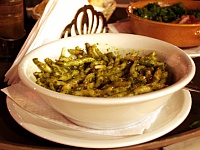 |
Pesto Alla Genovese |
Pesto is closely related to Liguria and to Genoa, because of the unique microclimate and the soil, ideal for growing several varieties basil. The traditional method of making pesto is with a marble mortar and a wood pestle (hence the name "pesto"). In order to allow the full release of the aroma, the basil leaves need to be crushed by hand in the mortar, using a round movement of the pestle, breaking the veins of the leaves and squeezing out the oil, rather than simply pounding the leaves. This is still considered to be the best way of preparing pesto. Sorry, food processor will not do in this case. Get ready for a little elbow grease and enjoy tha fact you are preparing food in a way the Romans used to.
The Genovese sauce is green due to the basil. Pesto alla siciliana, sometimes called simply pesto rosso (red pesto), is a sauce from Sicily similar to Genovese pesto but with the addition of tomato, almonds instead of pine nuts, and much less basil. Pesto alla calabrese is a sauce from Calabria consisting of grilled bell peppers, black pepper and more. These ingredients give it a distinctively spicy taste.
The traditional pasta to go with pesto are either trofiette or trenette (Trenette al Pesto).
Pesto alla Genovese
Ingredients:
- 1 1/3 lb (600 g) pasta
- 1/4 cup pine nuts, toasted, plus crushed pine nuts for garnish
- 1/4 to 1/2 cup olive oil, traditionally Ligurian
- 2 cups lightly-packed fresh, young basil leaves
- 1/4 teaspoon sea salt
- 1-2 cloves garlic, finley chopped
- 4 tbsp finely-grated Parmigiano-Reggiano cheese
- 2 tbsp finely-grated Pecorino-Romano cheese
- Special equipment: marble mortar and wooden pestle
Preparation:
- In a small skillet over medium heat, add the pine nuts and lightly toast until brown, shaking the pan continuously, about 3 to 4 minutes.
- Put the basil, the 1/4 cup pine nuts, garlic and the 1/2 tsp salt in a mortar. Using a pestle, grind with a rotating motion until a paste forms, about 5 minutes. The circular motion is needed to break the veins of the basil leaves instead of just crushing the leaves, as the veins contain the fragrant basil oils. Sorry, a food processor will not do in this case. A little elbow grease is required, while enjoying the fact you are preparing food the same way the Ancient Romans used to.
- Add the 1/4 cup cheese and continue grinding until well combined. Remove the pestle. Using a wooden spoon, briskly stir the pesto while drizzling in the 1/2 cup olive oil. The end result needs to be a paste, not a thin sauce,
- Adjust the seasonings with salt. Pour a small amount of olive oil on top of the pesto. Set aside.
- Cook the pasta al dente and drain.
- In a large bowl, combine the pasta, pesto and the reserved cooking water and toss gently to combine. Garnish with cheese and additional crushed pine nuts. Serve immediately.
- YIELD: Serves 6.
- Variation: Reduce the amount of pasta to 2/3. Substitute 1/2 lb each of boiled haricot verts, and boiled and sliced potatoes. In a large bowl, combine the pasta, haricots verts, potatoes, pesto and the reserved cooking water and toss gently to combine in a classic Ligurian preparation. Garnish with cheese and crushed pine nuts. Serve immediately.
- YIELD: Serves 4.
back to Radim and Lisa's Well-Travelled Cookbook | email us
Last updated: October 12, 2010
Photograph from Wikimedia Commons used under the terms of the GNU Free Documentation License.